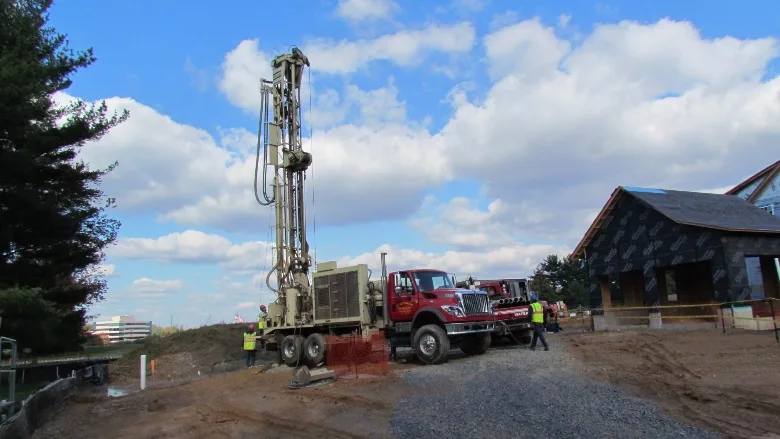Where Are All the Geothermal Drillers?
Heat-Pump Manufacturer Talks High Demand, Drilling Capacity

Tax incentives and subsidies do have an effect on the geothermal HVAC market. Enertech’s Jeff Lawrence says many drillers moved on during the time several years back when federal tax incentives lapsed.
Source: National Institute of Standards and Technology / Public Domain
Jeff Lawrence has watched the ups and downs of the geothermal industry for years from his perch as director of commercial accounts with Enertech Global LLC. The company builds geothermal products, including heat pumps, as well as solar solutions.
“You know, as an engineer or manufacturer or installer, you’d always wished and hope that this will come around,” Lawrence say of today’s geothermal market. “I mean, 10, 15 years ago, we dreamed about this stuff and now it’s reality, but to have a large loop field that serves several hundred homes is very common now.”

But there’s more work to do, Lawrence says. That work requires drillers, many of whom left geothermal work when federal tax incentives lapses several years ago — even though that lapse proved temporary.
We brought Lawrence on our Drilling In-Site video and podcast series to discuss the state of geothermal, renewable trends and how to lure drillers back into geothermal. This is an edited summary of our talk. Click here to see the full video, or here to listen to the podcast.
Q. Interest in moving away from combustion heat sources for homes and businesses seems to be on the rise, particularly if you look at places like Canada and New York State. Given that, is the first-cost issue still a problem in the geothermal industry?
A. That’ll always be something to talk about: first cost and how do we eliminate that or reduce it? That’s where the incentives come in. The 30% tax credit or the current rate of 26% — or it goes down to 24% — that’s going to really help offset the loop field cost for a typical homeowner. But the drive now for electrification is huge. It’s a huge trend right now, a big buzzword. They’re not distributing natural gas anymore in some areas. That was happening a couple years ago in New York. They said, “Alright. The pipe is capped here. We’re not going to do it anymore.” And that’s just a ripple effect. The same thing is happening out west in Washington, Seattle, Oregon. In fact, I believe in Seattle they can no longer do on site combustion. It’s just against code. [Ed. note: Both Washington State and Seattle have considered but not yet passed proposals to phase out gas heat in new buildings by 2030 and existing ones by 2050.] So they have to use some type of electric-driven device to make everything — hot water, domestic water, heating, whatever the case might be. So that’s going to drive this harder. Again, that’s where it’s so important to get drillers back into doing geothermal. When we lost the tax credit in 2017, a lot of drillers just went back to doing conventional work, water wells or environmental-type work, things like that. They’re kind of staying there because they’re just too busy to do something different like geothermal. It’s tough to get them to switch industries like that once they’re set up and doing this kind of stuff. They don’t want to change. That’s the nature of a red-blooded American: We don’t like change.
Q. How do we get more drillers involved into geothermal then?
A. I wish there was an “easy” button for that, because I’m telling you that’s the biggest hurdle that we have right now is getting drillers to commit to do geothermal. It’s kind of a weird industry because … installers and drillers have to work hand-in-hand. Typically, it’s the installer, the HVAC installer subs out a driller. It’s very rare that you get a one-stop shop where a guy has and installation crew and a drill rig to do all that. They’re constantly subbing out the drilling work. [But] like I said, after that switch when we lost the tax credit, so many drillers went back to doing other types of work. When geothermal became — I mean, it’s always been popular, but the industry’s grown substantially, the drillers just didn’t come back. Let’s face it, they’re probably worried about losing the industry again. Like I said, I wish there was an “easy” button.
We’ve got to raise the awareness, the interest.
How do we get them to come back and do more? It’s stuff like this. We’re talking about it. We’ve got to raise the awareness, the interest. We need to also recommend that they do peer-to-peer mentoring, even though they’re fellow competitors or whatnot. A second- or third-generation driller has always done water wells and now they hear this buzz about geothermal. You know, they’re reluctant to get into it because their father said, “Nope. We just do water wells,” and they’re stuck on that. It’s a good thing to get to a show, like we were just at the national show (the combine NGWA/IGSHPA convention) back in December in Nashville. We were there with IGSHPA, and that was just a great marriage — to bring those two industries together to raise the awareness and show them, “Hey geo is still here. In fact, we’re growing at a pretty big rate and need more drillers out there.” We’re all ears to promote and help out.
Q. From a manufacturing view, what kind of challenges does a company like Enertech see in 2022?
A. It is a challenge every day. I mean every day, there’s something. They’re supposed to ship us, you know, 400 units of this or that, and 10 show up at the dock. There’s no rhyme or reason. It is just horrendous what’s going on right now, from getting components, raw materials, from sheet metal to heat exchangers — something as simple as a compressor blanket. We’re having trouble getting just the little things. And, of course, the infamous computer chip. That held us up for a while, and it still comes up once in a while. It’s just that one little thing can hold up a whole order, because when we manufacture something we have to do the whole thing and complete it and test it. I know like Ford, for instance, they got a bunch of vehicles sitting someplace waiting to put a computer chip in. That’s fine if they can do that, but we just can’t. We have to have all the parts before that goes down the assembly line. That’s just our practice, and to test it, it it’s just too much time to bring it back in and retest it to put those parts in there. So that holds us up a lot. In fact, in ’21, we had to send some people home because we just couldn’t build anything.
You asked about freight, delivery, distributional and all that. I mean look what’s going on at the border for Canada right now. We have, I think there’s at least 40 units sitting there waiting to go across the border, but just can’t get a truck to come over and get it is. It’s just a challenge.
Q. What is the major blocker to the wide adoptions of geothermal?
A. It’s always been just the awareness. Geothermal is certainly a buzzword now because of the electrification push and the green push, zero-carbon, net zero. They all go hand-in-hand. But, as Americans, we’re conditioned to not think or worry about our heating and cooling system as long as it turns on and keeps our home warm and cools when we want to be cool, we don’t care. That’s really the mentality, and then when you introduce something different, like I said before, us Americans, we don’t like change.
Now here’s something different, and not only that it costs more, so a typical homeowner is going to be resistive to, number one, change and, two, the cost of it. Unless we’re clever and explaining upfront, “Yes, it costs more, but you got this incentive at the federal level. Sometimes there’s utility rebates or state rebates. There’s always some kind of financial tool that can help.” So that’s the tough part, is selling it using that bag of tricks that we have available to sell to the homeowner. It’s just the awareness. It’s really tough to break down that barrier. My favorite thing is to be at a home show and talk to a homeowner. I say, “So, describe your house.” They just, you know, [talk about] elaborate marble this and polished granite countertops. So, wait a minute. What’s the payback on that polished granite countertop? “Well, that’s what I want, I don’t care what it costs.” So I try to spin the perspective and say, “Well, what do you want for your heating and cooling system? Do you want something efficient? Do you want something that’s ‘green’?” You got to find that hot button that is going to reel them in, and use that.
The Full Interview
We interviewed Jeff Lawrence of Enertech for episode 41 of our Drilling In-Site series. Our talk covered the 2021 Infrastructure Investment and Jobs Act, recent geothermal innovations and other topics. See the conversation at www.nationaldriller.com/insite, or listen to the podcast version at www.nationaldriller.com/insite-podcast. Episodes also on Spotify and Apple Podcasts. Search Drilling In-Site and tap Subscribe.
Working on an interesting project or have industry wisdom to share? Email verduscoj@bnpmedia.com to be considered for a guest spot on Drilling In-Site.
Looking for a reprint of this article?
From high-res PDFs to custom plaques, order your copy today!



